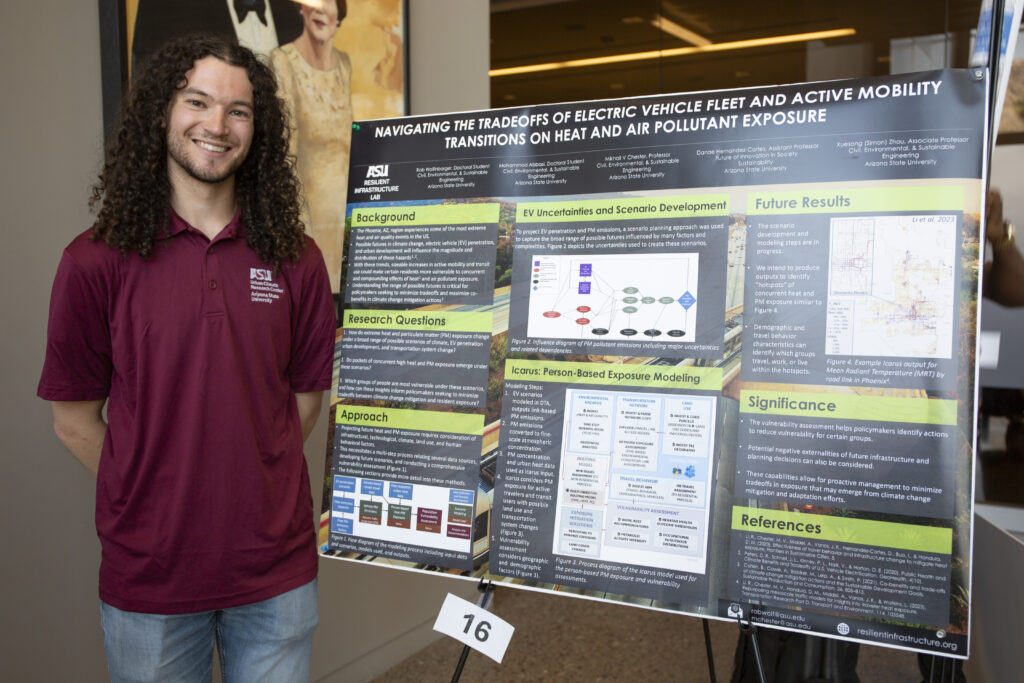By Clara Hall, October 2025
This section of the site is focused on showcasing ESSA scholars (students, alumni, faculty, and community members) making a positive impact within their research community, centering on diverse ways of knowing in their research, and sharing their knowledge and expertise. If you have a research product, event, or opinion you would like to share please contact [email protected].

Background
This spotlight features Rob Wolfinbarger, a third-year PhD student in Civil, Environmental, and Sustainable Engineering at Arizona State University. Rob’s research is driven by a passion for understanding how infrastructure systems can be designed, governed, and transformed to respond to the challenges of climate change and urban resilience.
From Oklahoma to Infrastructure Innovation
Originally from Norman, Oklahoma, Rob’s academic journey began at Purdue University, where he earned a degree in Environmental and Ecological Engineering. Seeking a broader perspective, he came to ASU to focus on civil engineering, drawn to the complexities of infrastructure and its role in shaping sustainable cities. “I wanted to move beyond traditional environmental engineering and dig into the infrastructure space, how we design, govern, and repair the systems that shape our lives and environments.”
Research Focus: Mapping Resilience and Well-being
Rob’s work centers on the intersection of infrastructure, climate change, and public health. One of his current projects examines the impact of large-scale electric vehicle (EV) adoption on regional air quality in Phoenix. Using traffic emissions modeling and the Icarus built environment exposure model, Rob and his team simulate how shifts in transportation affect particulate matter emissions and, ultimately, the exposure of active travelers, people outside vehicles, walking, biking, or using transit. These insights help cities anticipate health impacts, develop policies, and target strategies to improve air quality and public well-being.
A key concern is how exposure to extreme heat and air pollutants interact, compounding health risks for residents. “Phoenix’s geography and car-centric design create unique challenges. Even as we push for more transit and green space, cars remain critical heat refuges in a city where walking and biking can be dangerous during extreme temperatures.”
Frameworks for Urban Transformation
Rob’s research extends beyond technical modeling to broader questions of governance and policy. He is developing a framework for cities to assess their progress in three dimensions: mitigating emissions, adapting to climate hazards, and improving citizen well-being. Drawing on concepts like the “safe operating space” from planetary boundaries research, he envisions cities mapping their status and constraints, what he calls “lock-in” to identify pathways for systemic change.
“Every city faces constraints from geography, economics, culture, and legacy infrastructure. My work aims to help decision-makers recognize these lock-ins and strategize ways to unlock them, expanding the possibilities for safer, more resilient urban futures.”
Community, Collaboration, and Policy Impact
Much of Rob’s research is informed by collaborative projects like the Southwest Integrated Field Lab (SWIFL), a DOE-funded partnership among Arizona universities and national labs. SWIFL brought together hundreds of stakeholders, city governments, infrastructure agencies, nonprofits, and citizen groups, to develop climate adaptation plans for Arizona’s urban regions. “Stakeholder engagement is crucial. Our models and frameworks are designed to be tools for policymakers, helping them balance trade-offs and pursue co-benefits across mitigation, adaptation, and well-being.”
Rob emphasizes that infrastructure challenges are inherently political, often requiring buy-in from government, private sector, nonprofits, and citizens. “You can have the best technical solutions, but without broad stakeholder support, it is much more difficult to make progress.”
Navigating Barriers and Embracing Complexity
Rob identifies major barriers to implementing systemic change, including governance processes, disparities in resources, and the complexity of managing interconnected goals. “Cities with fewer resources may prioritize immediate well-being needs over long-term climate goals, and that’s understandable. My research is meant to help cities acknowledge their unique constraints and design strategies that fit their context.”
He also stresses the importance of science communication and public engagement. “If people can’t see the direct benefits of infrastructure investment, the pace and scale of infrastructure projects to meaningfully lower emissions and adapt to climate change will fall short of what is necessary. Better communication is essential for building support and making preparedness visible—so that investments in resilience are recognized and valued.”
The Role of ESSA: Interdisciplinary Perspectives
Rob’s experience in the Earth Systems Science for the Anthropocene (ESSA) program has broadened his perspective, bringing him into dialogue with social scientists, linguists, writers, and conservationists. “I’m usually the only engineer in the room, and that’s refreshing. It’s helped me see the value of holistic approaches, integrating social systems into engineering and communicating across disciplines.”
He notes that while engineers often overlook the social dimensions of infrastructure, social scientists may not fully grasp the technical systems they work within. “ESSA helps bridge that gap, fostering the kind of interdisciplinary thinking that’s essential for real change.”
Looking Forward: Toward Adaptive, Inclusive Cities
Rob’s goal is to contribute to better governance for infrastructure systems, making them more flexible, adaptive, and effective in an era of accelerating change. He advocates for science communication that connects research to public benefit and supports policies that are responsive to both immediate needs and long-term resilience.
“System thinking is complex, but it’s the key to creating cities that work for everyone. By understanding the connections and trade-offs between different goals, and by bringing diverse voices to the table, we can build urban environments that are safe, sustainable, and equitable.”